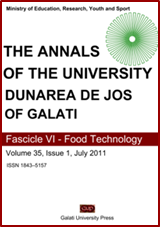Obtaining fermented dairy products with the yogurt culture YF-L 812
Abstract
Exopolysaccharides (EPS) produced by some lactic acid bacteria cultures can efficiently replace commercial stabilizers for preventing or reducing syneresis, providing fermented milk products with suitable structure viscosity. The effect of EPS on food quality characteristics depends on the EPS properties themselves, as well as their interaction with various components of the food system. This paper was aimed at studying the influence of the environment composition on the EPS biosynthesis by starter culture YF-L 812 and at determining the properties of at yogurt obtained. High fat content of milk (3.5% and 1.5%) had a positive effect on yogurt texture. In order to reduce the syneresis phenomenon, the milk with low fat content (0.1%) was supplemented with different concentrations of milk powder and lactose. Our results indicated that the whey separated was reduced to 0.6% and 0.3% when the milk was supplemented with 2% lactose and 2% skimmed milk
powder, and respectively, 3% lactose and 3% skimmed milk powder.


